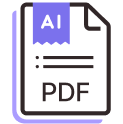
How to automate packing list digitization
Packing lists come in all shapes and sizes — but your team needs data formatted the same way every time, regardless of your supplier’s PDF format. By pulling structured data from packing lists, you can take action like auditing packing list details and pushing updates to siloed systems — but this is only made possible with clean, consistent data across your suppliers and vendors.
With Parabola, you can easily turn packing lists from messy PDFs into structured datasets using LLMs and computer vision. Parabola’s tool is designed to handle varying document formats, ensuring you can consistently extract data such as item descriptions, quantities, and package dimensions, regardless of layout differences. Beyond parsing data, workflows can use AI and data transformation steps to standardize values and integrate packing list data directly into inventory systems, enabling faster reconciliations and improved visibility into inbound shipments.

Video overview
Why Parabola







The ops team has become so dependent on Parabola—it has helped our workflow a lot.
What is packing list digitization?
Digitizing packing list PDFs involves extracting critical shipment details such as SKUs, item quantities, dimensions, and descriptions from physical or digital PDFs and converting them into structured data. These documents often come in inconsistent formats from suppliers or 3PLs, requiring workflows to account for variability to ensure data accuracy. By automating this process, teams can streamline operations, eliminate manual entry, and maintain a clear view of inbound inventory.
How to digitize packing lists in Parabola?
- Pull a packing list into Parabola using the Pull from PDF file or Pull from inbound email step.
- In the PDF parsing step, configure settings to extract key fields like SKU, item descriptions, quantities, and dimensions. Use the Keys section for document-level data (e.g., shipment IDs); use the Columns section for table data like items and quantities.
- Standardize and clean the extracted data using steps like Edit columns and Standardize with AI — mapping the packing list data to your internal format.
- Consider enriching packing list line items with data pulled from your ERP or reconciling your packing list against the original PO.
- Export structured data to a Parabola Table to maintain a historical record, or send it to a destination like Google Sheets, your ERP, or WMS for visibility and reconciliation.
Tips for digitizing packing lists in Parabola?
- To improve parsing accuracy, provide specific context for each data column in the PDF parsing step, including sample values and descriptions of where they appear in the document.
- Automate workflows for recurring packing list submissions by using the Pull from inbound email step.
- Combine parsed packing list data with shipment or order data using the Combine tables step to create a comprehensive view of inbound inventory.
What other resources are available on digitizing packing list PDFs?
- To start building your packing list digitization Flow, use the Template above and check out the Parabola University lesson on PDF parsing.
- Learn more about how to set up an auto-forwarding rule in Parabola here.









